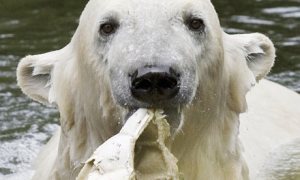Polar Bear (Ursus maritimus)
This post is dedicated to the memory of (cute) Knut, who was born in the Berlin zoo on 5 December 2006, and who died suddenly on 19 March 2011. Yesterday.
Knut is kind of a proxy for all of the beautiful and powerful polar bears in the wild whose exceptional abilities to survive in a harsh environment are being tested more and more each year due to climate change and the break up of the polar ice. This change is hardest on the cubs, as they are less able to swim the extra distance it now takes to get from the areas in which they emerged from their dens to the sea ice where they need to go to hunt. Knut was an exceptionally cute cub – but in this way he was exactly like all the other polar bears cubs, in zoos or in the wild. The video below documents his extraordinary powers of cuteness (thank you, Alex Trueman, for finding it).
In what other ways is the polar bear exceptional?
The latin name, ursus maritimus, suggests one – these bears could be classified as marine mammals. Unlike all other ursidae, ursus maritimus spends a great deal of time in the water. Polar bears are graceful and efficient swimmers.
Another extraordinary feature of the Polar bear is size. If we classify the Polar Bear as a terrestrial animal instead of an aquatic one, we’ve identified the largest terrestrial carnivore. Well, one of them – the Polar Bear and the Kodiak Bear are tied for this designation. Adult males can be up to 1500 pounds, and almost 10 feet in length.
Ancestral polar bears, ursus maritimus tyrannus, were even larger – below you can get an idea of the size of contemporary and ancient polar bears.
Polar bears are so extraordinarily well-insulated that they are reported to be nearly invisible in infra-red photography. They easily tolerate the most extreme of cold temperatures, and unlike other ursidae, they do not regularly hibernate.
In the wild, polar bears can live up to 30 years, which makes them pretty darned long-lived animals. And they are pretty darned fierce too – hungry polar bears have been known to hunt and eat humans, though they prefer seals. A satiated polar bear may not, however, be so ferocious – and in fact there’s a nice account of a group of bears who have befriended a group of husky dogs:
They seem to be quite curious and smart – and a recent project by the BBC to capture video of polar bears via ‘spy cams’ has generated some truly phenomenal footage. You should check out the BBC page for this programme, and view the clips.
One last controversial claim that must be addressed – some people claimed that when Knut grew up, he became un-cute. While it is clearly true that adult polar bears are majestic and powerful creatures who inspire both respect and fear – we would argue that they are also, decidedly, still cute. Our evidence?
Q.E.D.







Thanks for this enlightening post. A great tribute to our dear friend. And RIP, sweet, fuzzy Knut.
You need to take part in a contest for one of the most useful websites
on the net. I’m going to highly recommend this website!